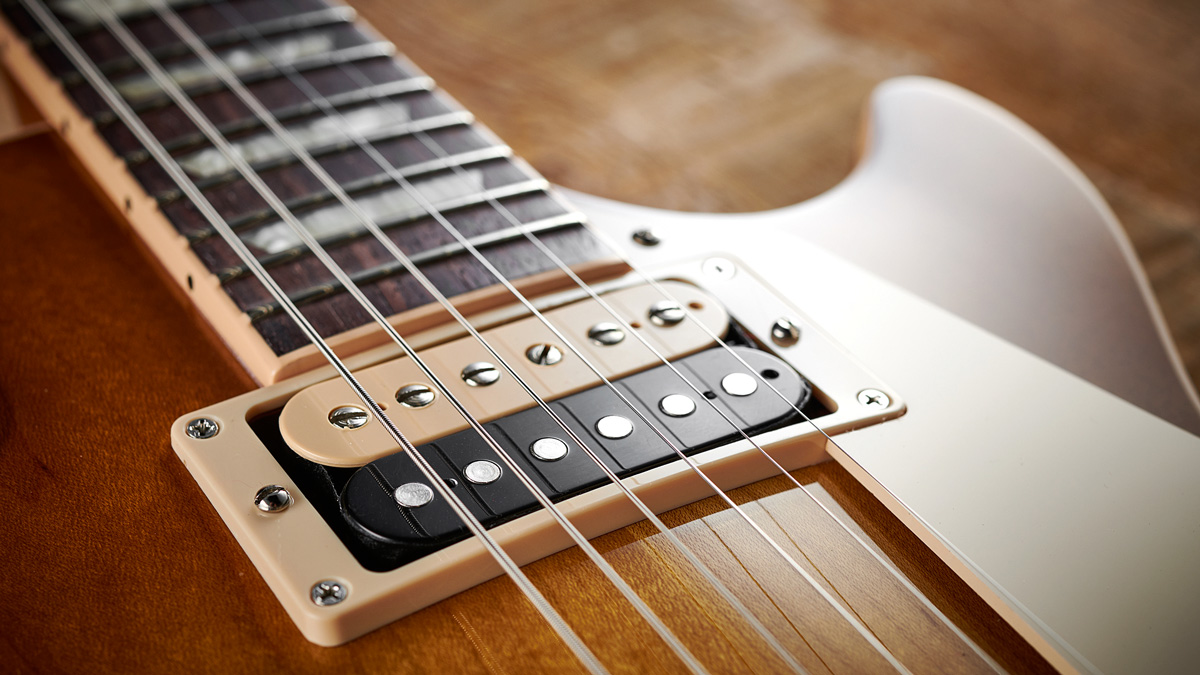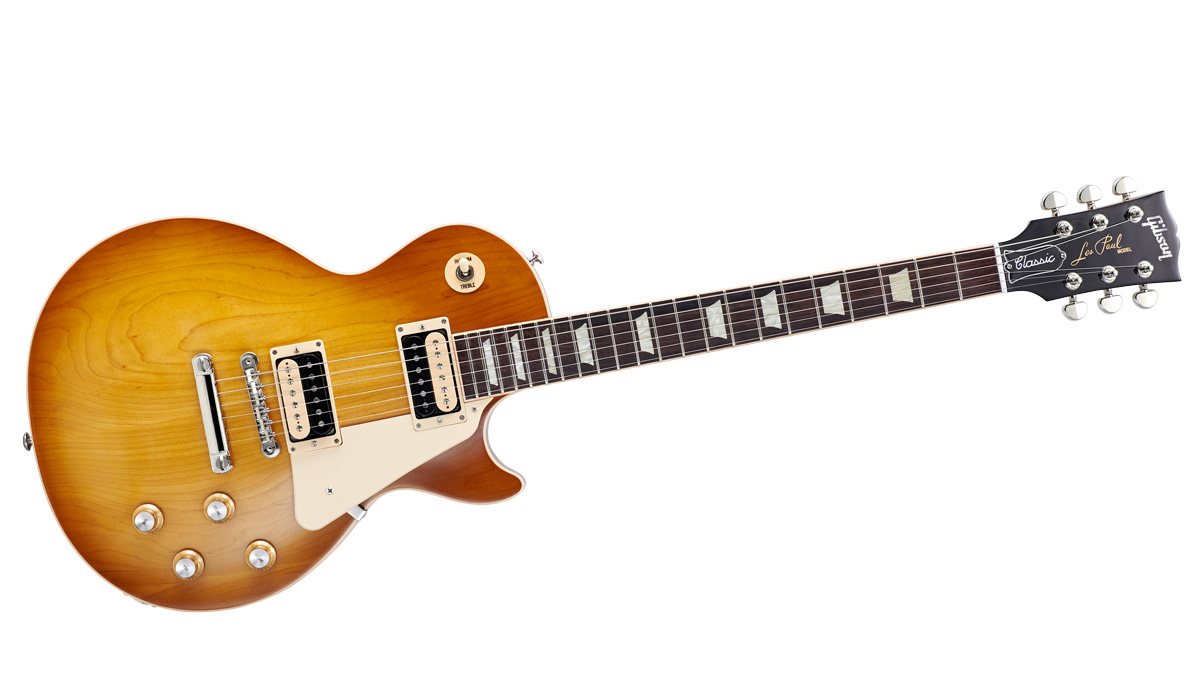MusicRadar Verdict
A heavyweight LP with a raft of usable tones.
Pros
- +
Good build with unshowy plain maple top.
- +
Pickups have a little more kick, plus we get expanded sounds.
- +
Good price.
Cons
- -
Over-heavy weight (despite the weight relief).
- -
Not everyone likes PCBs and push-fit connectors.
MusicRadar's got your back
While Fender splits its guitars into series and periodically updates or refreshes them, Gibson’s main USA production division prefers the annual makeover approach.
This year’s line-up was seen by many dealers as a return to form: “A new chapter in Gibson’s illustrious history, with their focus firmly back on crafting only the world’s finest guitars!” said one. As ever, the Les Paul sits central, with eight models (if we count The Paul 40th Anniversary) bookended by the start-up double-cut Les Paul Junior Tribute and topped off with the Les Paul High Performance. Add to the list the Les Paul Studio and Studio Tribute, and that leaves us with the three most classic Les Pauls, the Standard, Traditional and Classic. Today we’re looking at the Classic.
The Classic is a catch-all name and for 2019 swaps its 2018-spec dual P-90s for ’61 Zebras and adds the circuit board previously used on the Standard, along with Traditional (aka nine-hole) weight relief. At £900 cheaper than the Standard, the 2019 Classic is essentially a stripped-down Les Paul before you drop to the Studios and is offered in Honeyburst (as here) or Gold Top - it was originally also offered in Ebony and Heritage Cherry Sunburst.
Outwardly, all three of the 2019 models share the same construction (one-piece neck, headstock widening wings and two-piece centre-joined backs). The Classic features a A-less ‘plain top’ and ’61 Zebra open coil pickups.
Build
This Classic name has been applied to various-spec LPs since it appeared back in 1990, then in a highly vintage spec. Today’s more cost-effective dress, with its plain maple top, evokes a more 70s Deluxe style, enhanced by the metal-topped knobs. Unfortunately, that perception is reinforced by its weight, which makes it the porker here (despite its Traditional Weight Relief ) at a whooping 4.7kg/10.4lb. Grover Rotomatics reference one of the most common LP mods and we get a no-wire ABR-1 tune-o-matic.
Likewise, the ’board appears very dry and with such low-profile frets you do really feel the ’board’s surface more than you would with a higher wire. String height is identical to the others and neck relief sits between the two.
Sounds
The Classic has an initial response that all points to a strong plugged-in performance. The Classic’s neck feels very similar to the recently-reviewed Standard, despite the differences, but the weight has a big impact, particularly on the hugely unbalanced feel played seated. Of course, if that doesn’t bother you, you might be on to a winner here as it’s a great player as supplied.
Like any classic design, what you hear coming out of your amp might not be your idea of a great Les Paul tone, yet playing these three we’re hearing wonderful and subtly different flavours. It might well be that the Classic has the bite and power you like with more lower-end grunt than the others.
There’s a little more nasally P-90 flavour, a slightly cocked-wah voice that provides a grainy texture, especially with some crunch and Marshall-y gain. Running the Classic with both pickups in tap mode is quite something; experiment with the phase switch with both pickups on to hear it. If only the damn thing wasn’t so heavy...

The rather dowdy-looking Classic’s fundamental flaw is its colossal weight: in a different colour and with a lighter weight it might be game on, but that’s not what’s here. Plugged in, is where the Classic drops in: heft and grunt aplenty but with enough clarity to access older snappier and soulful voices.
It will no doubt be a while until ‘new Gibson’ settles in and has a noticeable effect on the instruments we can buy. These interim models, however, are three strong dishes that employ existing features we’ve seen before, albeit not in quite the same combinations.
With the horrors of ‘robotic’ tuners, over-wide necks and zero frets now pretty much consigned to the past, these three zone in on the Les Paul in classic style (Traditional), sonically expanded (Standard) and affordable (Classic) shades. They need a little TLC, which we’d hope would be undertaken before they’re sold, but they’re tidy, not over-priced and have the right name on the headstock.
They might well be quite historic models, too: the end of an era. Just as we conclude our test at the start of 2019, the new Gibson management announced there will apparently be a completely new 2019 range of ‘Classics’.
“Designs like the Les Paul and the SG once again embrace the features and construction details that made them legends in the first place: a Les Paul Standard ’50s spec and a Les Paul Standard ’60s spec as well as one with P-90 pickups,” says Cesar Gueikian, Gibson’s chief merchant officer. “The Contemporary line also introduces a new concept with the Les Paul and SG Modern.” These new ranges “will be available for purchase later this year”.
What that means for these original and clearly short-lived 2019 models that are in-store is anyone’s guess, but we suspect as the year progresses there will be deals aplenty to be had (2018 models are already discounted in many stores). Whatever happens while the dust settles, it looks like 2019 is going to be quite a year for Gibson lovers. Watch this space!
Dave Burrluck is one of the world’s most experienced guitar journalists, who started writing back in the '80s for International Musician and Recording World, co-founded The Guitar Magazine and has been the Gear Reviews Editor of Guitarist magazine for the past two decades. Along the way, Dave has been the sole author of The PRS Guitar Book and The Player's Guide to Guitar Maintenance as well as contributing to numerous other books on the electric guitar. Dave is an active gigging and recording musician and still finds time to make, repair and mod guitars, not least for Guitarist’s The Mod Squad.
Brace yourself: Bryan Adams didn’t buy his first real six-string in a five and dime
“Nobody listens to one genre. I literally don’t know anybody who listens to one genre. You can be a fan of so many different artists at once”: Laufey on what Gen Z can teach the rest of us about how to appreciate music
Bon Iver - ranked: from Sable, Fable to For Emma, Forever Ago











